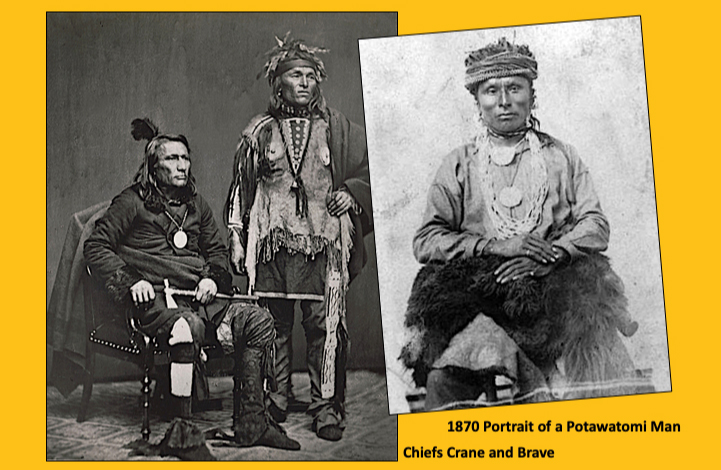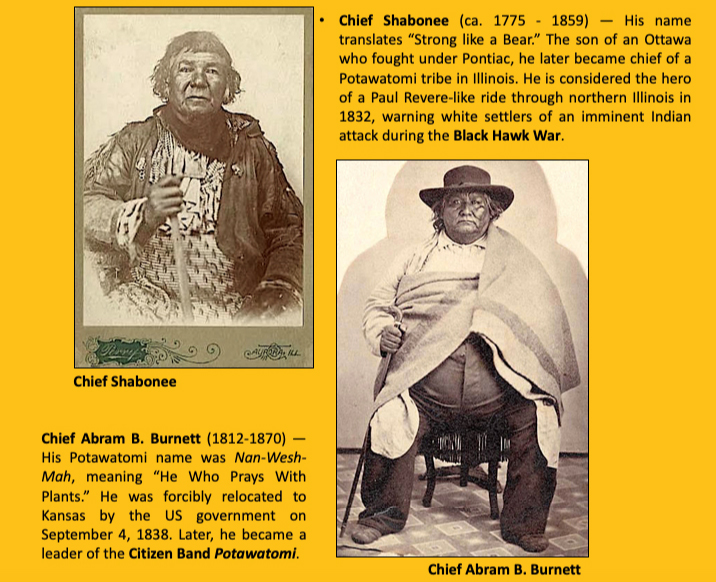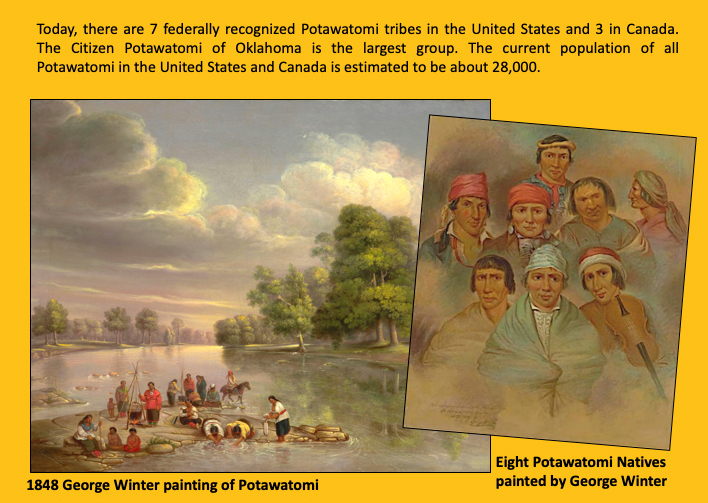“Alas for us! Our day is o’er
Our fires are out from shore to shore;
No more for us the wild deer bounds –
The plow is on our hunting grounds.
The pale man’s ax rings through our woods
The pale man’s sail skims o’er our floods;
Our pleasant springs are dry.
Our children look with power oppressed
Beyond the mountains of the west
Our children go – to die!”
- Simon Pokagon, Potawatomie Chief, author of
The Red Man’s Rebuke (1893)

he Potawatomi are an indigenous people who lived in the upper Mississippi River and Great Lakes region. They called themselves Neshnabé, meaning “Original People” because they were here long before the white settlers.
Archaeological records indicate Native people’s presence in the Midwest going back over 15,000 years, covering many different major cultural shifts.
In the 1600s the Potawatomi were living mainly in Michigan and Canada. However, following the Beaver Wars (1630-1700) with the Iroquois, many Potawatomi and Miami sought refuge by moving south. By 1790 groups of Potawatomi had settled north of the Wabash River and along Lake Michigan in northern Indiana.
Along with the Ojibwe and Ottawa, the Potawatomi were part of a tribal alliance known as the Council of Three Fires. Considered the “youngest brother,” the Potawatomi were called Bodéwadmi, or “Those Who Tend the Hearth Fire.”
Potawatomi warriors took part in Tecumseh’s War, the War of 1812, and the Peoria War. During this period their allegiances switched back and forth between Great Britain and the United States. The Milwaukee Potawatomi supported the Americans as they had done during the Revolution. The St. Joseph and Huron bands were divided, with some remaining neutral and others joining Shawnee Chief Tecumseh with the British.
Under Andrew Jackson’s Indian Removal Act of 1830, the Potawatomi and other tribes were gradually resettled to lands west of the Mississippi. The Potawatomi were removed in two groups: the Prairie and Forest Bands from northern Illinois and southern Wisconsin went to Council Bluffs in southwest Iowa; the Potawatomi of the Woods (Michigan and Indiana bands) were relocated to eastern Kansas.
By 1837, Jackson had removed 46,000 Native American people from their land east of the Mississippi River.
The removal of the Potawatomi did not go smoothly. Some bands simply slipped across the border into Ontario where they have remained ever since. Chief Menominee and his band at Twin Lakes refused to sign any of the treaties.



Notable Chiefs of the
Tippecanoe and
Wabash River Potawatomi
• Chief Aubenaubee (1761–1838) on the Tippecanoe River.
• Chief Askum (“More and More”) on the Eel River.
• George Cicott (ca. 1800 – 1833).
• Chief Keesass on the Wabash River.
• Chief Kewanna (1790–1840s) (“Prairie Chicken”) on the Eel River.
• Chief Kinkash (see Askum).
• Chief Magaago.
• Chief Monoquet (1790s–1830s) on the Tippecanoe River.
• Chief Tiosa on the Tippecanoe River.
• Chief Winamac (“Catfish”) allied with the British during the War of 1812.
• Chief Winamac (“Catfish”) allied with the Americans during the War of 1812.
These two Winamacs have often been confused with each other.
• Chief Menominee and his Yellow River Band Potawatomi.
• Chief Putwin (“Bear’s Butt”), the leader of the Brown River Potawatomi.

• Chief Shabonee (ca. 1775 - 1859) — His name translates “Strong like a Bear.” The son of an Ottawa who fought under Pontiac, he later became chief of a Potawatomi tribe in Illinois. He is considered the hero of a Paul Revere-like ride through northern Illinois in 1832, warning white settlers of an imminent Indian attack during the Black Hawk War.

• Chief Abram B. Burnett (1812-1870) — His Potawatomi name was Nan-Wesh-Mah, meaning “He Who Prays With Plants.” He was forcibly relocated to Kansas by the US government on September 4, 1838. Later, he became a leader of the Citizen Band Potawatomi.

Today, there are 7 federally recognized Potawatomi tribes in the United States and 3 in Canada. The Citizen Potawatomi of Oklahoma is the largest group. The current population of all Potawatomi in the United States and Canada is estimated to be about 28,000.
|








